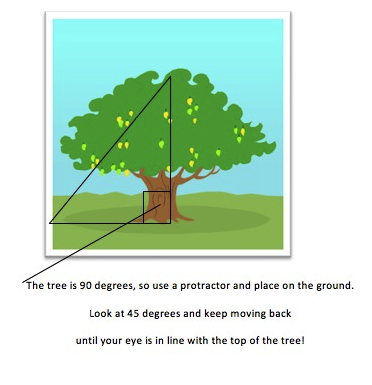Or search by topic
Number and algebra
Geometry and measure
Probability and statistics
Working mathematically
Advanced mathematics
For younger learners
How Tall?



- Problem
- Getting Started
- Student Solutions
- Teachers' Resources
We have had a good variety of thinking demonstrated in the responses received via emails. Here is a selection.
From Philippa at King's School Chester in England:
First of all, you need to wait until the sun is half way up the sky so the shadow is not too stretched and it is not mid-day so it is not right above the tree. When the time is right, you need to measure the shadow. I recommend a tape measure or a metre stick to do this. When you have the measurement you can say that this is the height of the tall tree.
From Dominic at Thomas Jolyffe School in the UK:
Measure a piece of wood and then stand it vertically on the ground and measure the length of its shadow. Quickly measure the shadow of the tree. Then work out the ratio of the length of the piece of wood to its shadow and this would be the same as the ratio of the height of the tree and the length of its shadow. Obviously this can only be done on a sunny day!
The Maths club from Chesham Prep School in England wrote:
We thought about using the tree's shadow but that would only work if
1. It was sunny
2. It was midday (otherwise the shadow would be shorter or longer, depending on the angle of the sun.
We knew how high $1$m was so we were able to estimate the height of the tree.
We knew how tall a member of the group was and he stood against the tree.
We then used his height to estimate the height of the tree.
We then used these estimates plus an imaginary diagonal line from the top of the tree to the ground. We then measured along the ground from that point to the tree.
Jiayuan from Harbord Collegiate Institute in Canada sent in:
Use a stick. When it's noon, put the stick straight and measure the width of
the shadow, and measure the width of the shadow from the tree.
Length of the stick : Width of the stick shadow = Height of the tree :Width of the tree shadow.
Holly from Guildford High School in England said she found the height without any danger. Here is the picture she sent in;

Other ideas came from:
Isobel and Harry at St. John the Baptist School in England:
I would measure something realistic against the tree for example a $6$ foot fence and compare it with that then stand back and calculate how many times taller it is going up in $6$ foot at a time.
Another idea from Abigail also at St. John the Baptist School:
Measure the tree on the screen in cm. Then make a key of $1$cm=$5$m. This will be an approximate height of the tree.
"Use angles and trigonometry" thought Alistair from Crosscrake School in England:
The children could calculate the height of the tree using simple trigonometry. What they should do is place an object somewhere nearby the tree, measure the distance between the tree and the object, and measure the angle of elevation of the tree from the rock. From this information, they could calculate the height of the tree with tan.
Well, here is a very different approach from Robyn at Brynhyfryd School in Wales:
I would climb the tree and send the very long measuring tape down to my friend.
St. Peter and Paul Primary School in England. Brian, Harshan and Edrich sent in these three separate ideas:
Brian - The shadow of the tree is the same length as the tree if it is sunny you can measure it in metres every time it is sunny it will be longer and in winter it will be smaller.
Harshan -Get a ladder and measure.
Edrich - First I will wait for a sunny day then I will measure its shadow. For example if I m $1.5$ meters my shadow will be $2.4$ meters so by calculating their space I can found the tree's length.
Finally Athena from EMS in the USA had another idea:
Use a yard stick to measure the tree by slowly sliding it or use ruler to measure the length of your hand in inches then slowly climb tree while vertically putting one hand on top of another on the trunk.
Well done! So many different ideas. Thank you for your efforts and for sending them in.
You may also like
All Change
There are three versions of this challenge. The idea is to change the colour of all the spots on the grid. Can you do it in fewer throws of the dice?
What's in a Name?
Here's a very elementary code that requires young children to read a table, and look for similarities and differences.

